1. Oil palm leaf-derived hierarchical porous carbon for “water-in-salt” based supercapacitors: the effect of anions (Cl− and TFSI−) in superconcentrated conditions
Arisa Phukhrongthung, Pawin Iamprasertkun, Aritsa Bunpheng, Thanit Saisopa, Chakkrit Umpuch, Channarong Puchongkawarin, Montree Sawangphruk, Santamon Luanwuthi
RSC Advances, 2023, 13, 24432-24444
DOI: 10.1039/D3RA03152G
Abstract: This study investigates the use of a hierarchical porous carbon electrode derived from oil palm leaves in a “water-in-salt” supercapacitor. The impact of anion identity on the electrical performance of the carbon electrode was also explored. The results show that the prepared carbon had a hierarchical porous structure with a high surface area of up to 1840 m2 g−1. When a 20 m LiTFSI electrolyte was used, the carbon electrode had a specific capacitance of 176 F g−1 with a wider potential window of about 2.6 V, whereas the use of a cheaper 20 m LiCl electrolyte showed a higher specific capacitance of 331 F g−1 due to the smaller size of the Cl− anion, which enabled inner capacitance. Therefore, the anion identity has an effect on the electrochemical performance of porous carbon, and this research contributes to the understanding of using “water-in-salt” electrolytes in carbon-based supercapacitors. The study's findings provide insights into developing low-cost, high-performance supercapacitors that can operate in a wider voltage range.

2. Exploring the impact of metal oxide coating and metal atom doping on the electrochemical performance of Ni-rich cathode materials
Panyawee Bunyanidhi, Nutthaphon Phattharasupakun, Salatan Duangdangchote, Surat Prempluem, Nattanon Joraleechanchaia and Montree Sawangphruk
Journal of Materials Chemistry A, 2023, Advance Article
DIO: https://doi.org/10.1039/D3TA06104C
Abstract: In this research, we systematically examine the impact of atomic cation dopants and metal oxide coatings, including their respective oxidation states, on the electrochemical performance of Ni-rich NCA90 cathode materials. The study reveals that dopants exhibiting varied oxidation states, derived from high annealing temperatures, can efficaciously mitigate H2–H3 phase transitions, thereby amplifying the structural stability of the materials. Complementary Density Functional Theory (DFT) calculations corroborate that a judiciously selected dopant can enhance the electronic attributes of the cathode materials. Notably, the incorporation of a tungsten dopant is found to markedly modulate the kinetics of lithium transfer throughout the battery cycling process. This research provides vital insights into the role of cation dopants and metal oxide coatings in optimizing the electrochemical performance of Ni-rich cathode materials.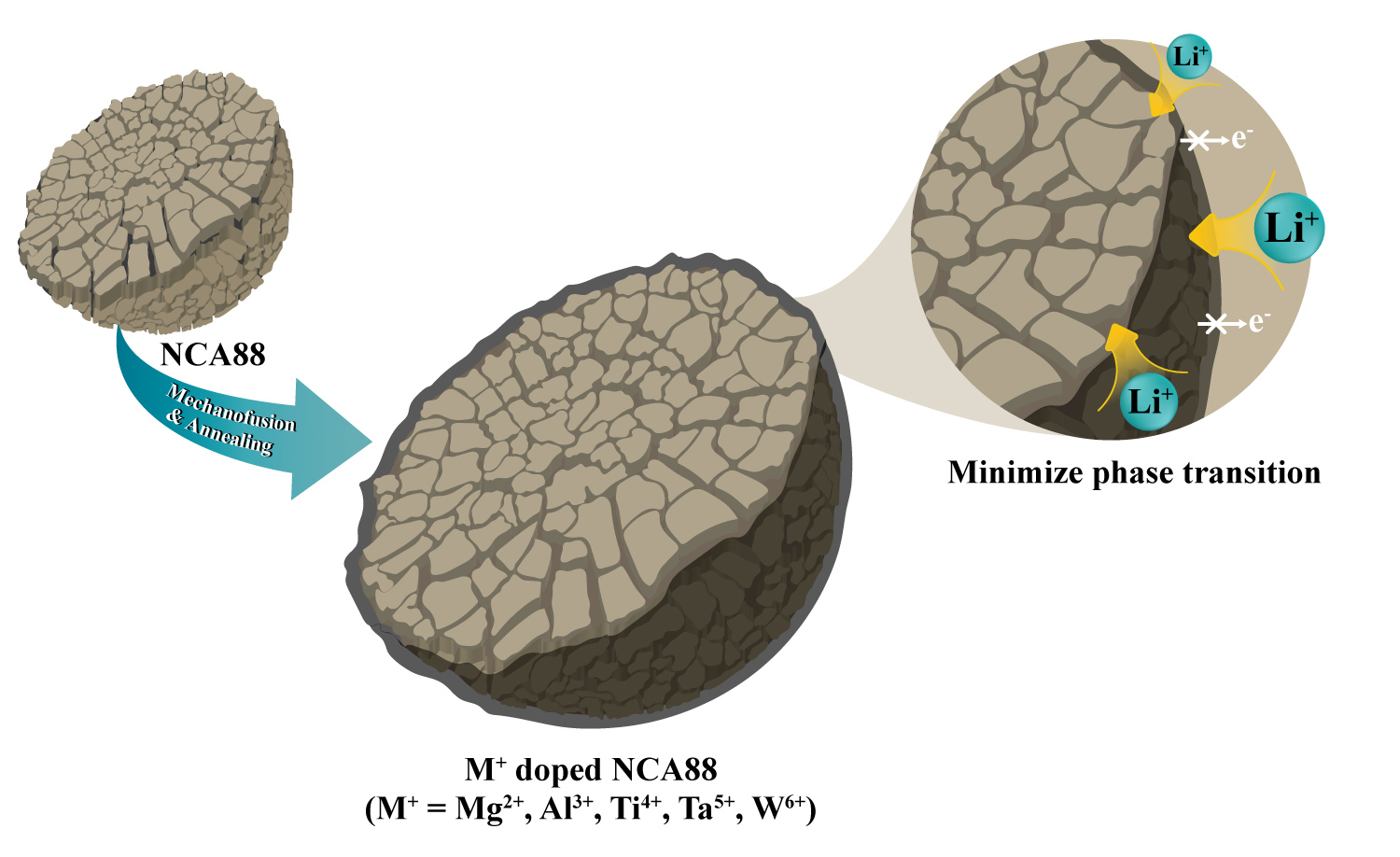

3. Insight into the effect of thick graphite electrodes towards high-performance cylindrical Ni-rich NCA90 Li-ion batteries
Nattanon Joraleechanchai, Thitiphum Sangsanit, Kan Homlamai, Purin Krapong, Montree Sawangphruk
Journal of Energy Chemistry, 2023, 87, 322-333
DOI: https://doi.org/10.1016/j.jechem.2023.08.026
Abstract: This study explored the complex effect of graphite tortuosity on the electrochemical performance of Ni-rich NCA90 Li-ion batteries (LIBs). Different levels of graphite anode tortuosity were analyzed, revealing that low-tortuosity electrodes had better graphite utilization. The in-plane tortuosities of the graphite anode electrodes examined were 1.70, 1.94, 2.05, and 2.18, while their corresponding through-plane tortuosities were 4.74, 6.94, 8.19, and 9.80. In-operando X-ray diffraction and differential electrochemical mass spectrometry were employed to investigate the charge storage mechanism and gas evolution. The study revealed that while graphite electrode tortuosity impacted the amount of Li present in the lithiated graphite phase due to diffusion constraints, it did not affect gas generation. The Li-ion utilization in low-tortuosity electrodes was higher than that in high-tortuosity electrodes because of solid-diffusion limitations. Additionally, the galvanostatic intermittent titration technique (GITT) was employed to investigate a lithium-ion diffusion coefficient. Our results indicate that the lithium-ion diffusion coefficient exhibits a significant difference only during LiC6 phase transition. We also observed that the use of a lower tortuosity electrode leads to improved lithium-ion insertion. Consequently, graphite utilization is influenced by the porous electrode design. Safety tests adhering to UN38.3 guidelines verified battery safety. The study demonstrated the practical application of optimized NCA90 LIB cells with diverse graphite electrode tortuosities in a high-performance Lamborghini GoKart, paving the way for further advancements in Ni-rich LIB technology.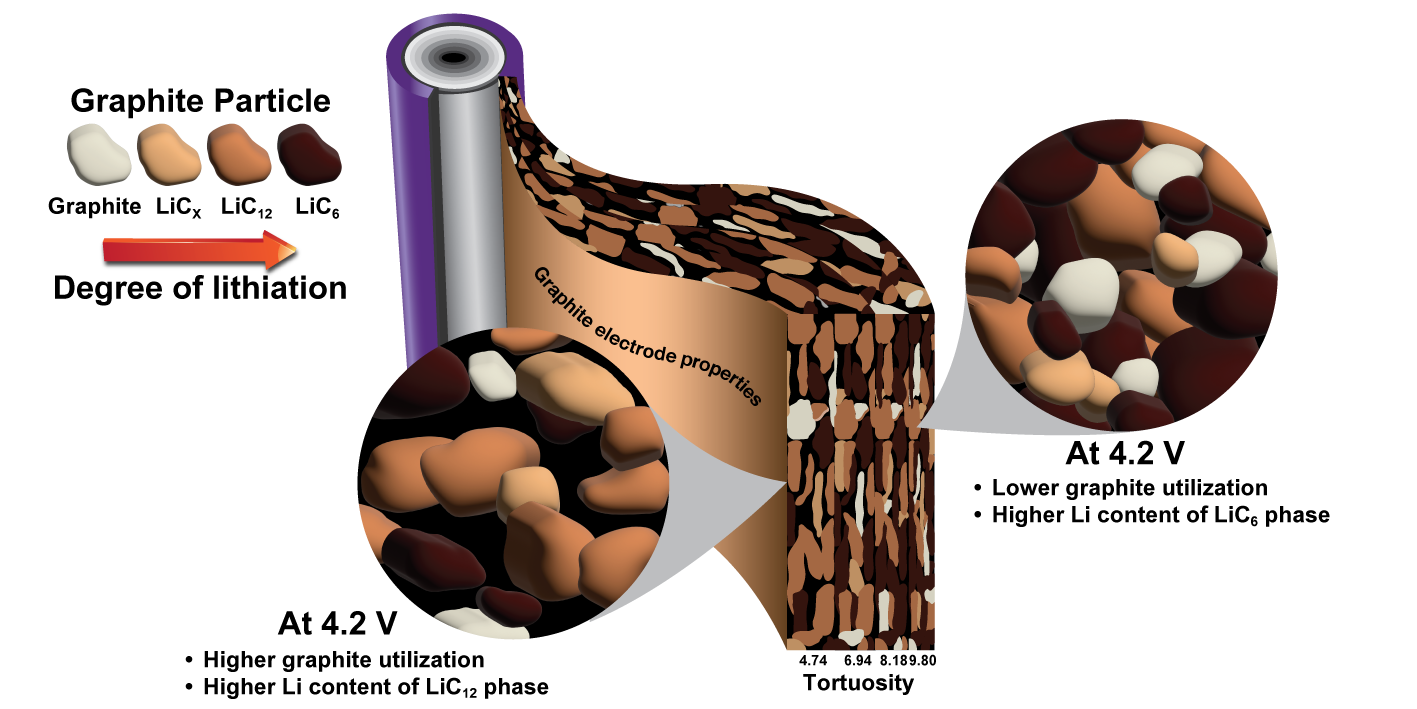

4. Large-scale production of 18650 cylindrical supercapacitors: Effects of separators, electrode thickness, electrolyte additives, and testing protocols
Surasak Kaenket, Phansiri Suktha, Ketsuda Kongsawatvoragul, Thitiphum Sangsanit, Phatsawit Wuamprakhon, Ronnachai Songthan, Worapol Tejangkura, Kanruthai Santiyuk, Kan Homlamai, Montree Sawangphruk
Journal of Power Sources, 2023, 581, 233512
DOI: https://www.sciencedirect.com/science/article/pii/S0378775323008881
Abstract: Although supercapcitors have been widely studied, large-scale 18650 cylindrical supercapacitor cells have been rarely investigated and reported. Here, we investigated the effects of polymer separators, electrode thickness, electrolyte additives, testing protocols, reproducibility, and stability of the supercapacitors at the large-scale pilot plant. The supercapacitor cells with polyethylene (PE) and Al2O3-coated PE separators are good at low and high specific currents, respectively. The Al2O3-coated PE exhibits better stability than the one with the PE separator. The supercapacitor with a thickness of 250 μm has a cell capacitance of over 120 F from 100 to 1000 mA, which is higher than that of the other cells studied in this work. Also, the cell capacitances of supercapacitors can be enhanced by having redox mediator additives. 25 mM hydroquinone and ferrocene methanol are the optimized concentrations. We also found that the cell capacitance and equivalent series resistance of the supercapacitors are sensitive to the testing protocol, for which the highest capacitance was observed using the IEC62391-1 standard method, followed by the Maxwell method and conventional galvanostatic charge discharge method without dwell time. High reproducibility and stability of the as-fabricated supercapacitors in this work may lead to the further development of practical large-scale supercapcitors in the future.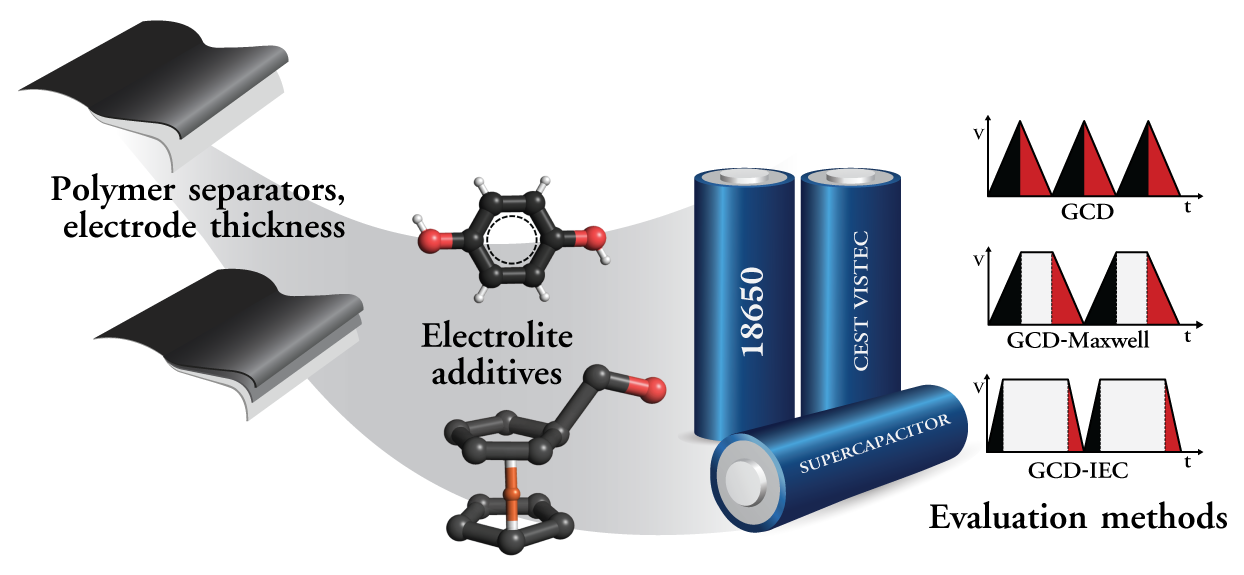

5. Insight into the failure mechanism of large-scale cylindrical lithium–sulphur cells
Surasak Kaenket, Salatan Duangdangchote, Kan Homlamai, Nattanon Joraleechanchai, Titipum Sangsanit, Worapol Tejangkuraa and Montree Sawangphruk
Chem. Commun., 2023, Advance Article
DOI: DOIhttps://doi.org/10.1039/D3CC02730A
Abstract: Li–S batteries with a sulphur loading content of 5 mg cm−2 were produced as large-scale 18 650 cylindrical cells. We have found that a key failure mode of cylindrical Li–S battery cells is the severe capacity fading during the galvanostatic charge–discharge process due to the corrosion of the electrodes, the electrolyte decomposition, and the severe polysulphide shuttling effect.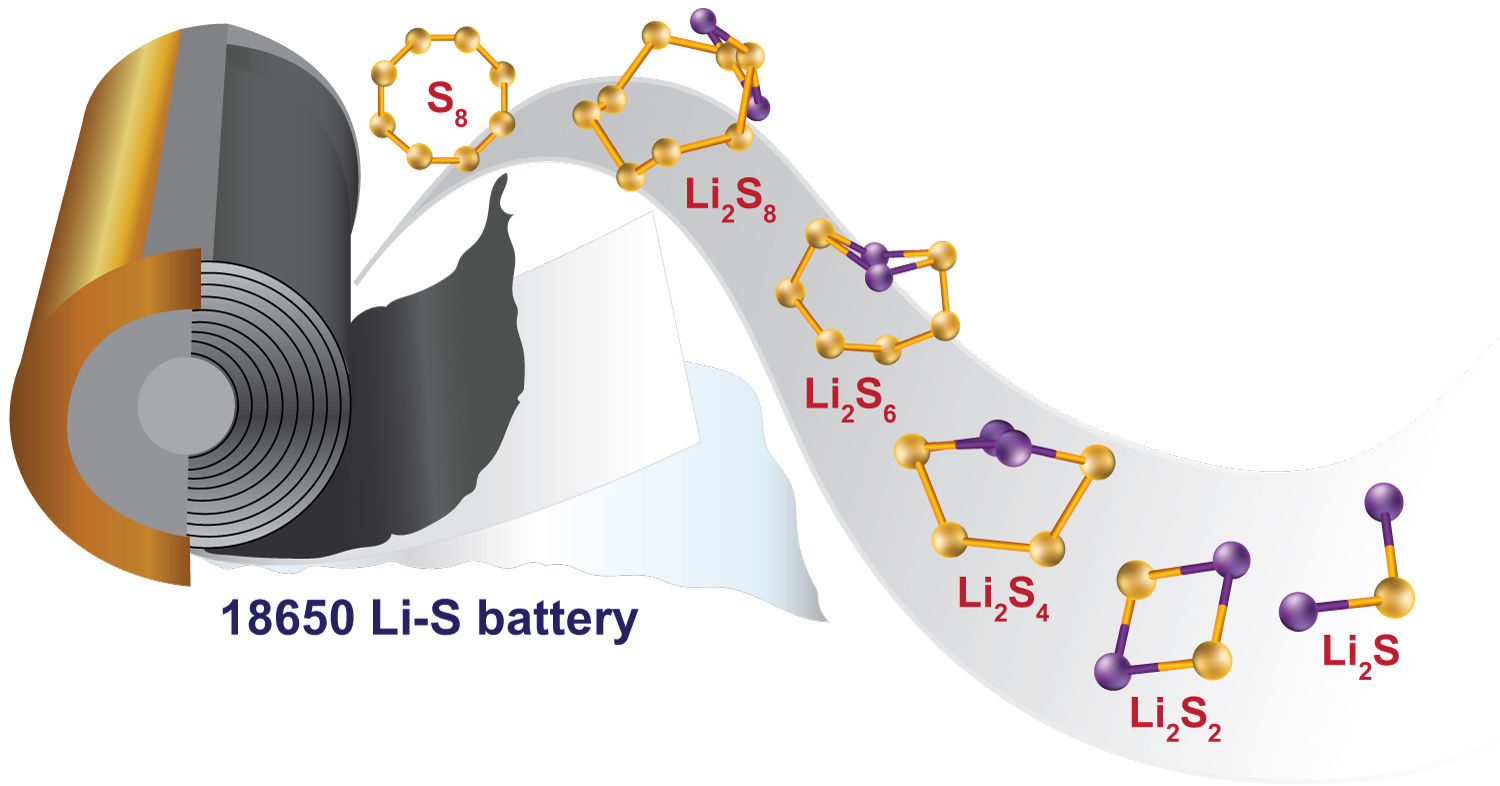

6. Review of the Scalable Core–Shell Synthesis Methods: The Improvements of Li‐Ion Battery Electrochemistry and Cycling Stability
Suchakree Tubtimkuna, Dmitri L Danilov, Montree Sawangphruk, Peter HL Notten
Small Methods, 25 May 2023
DOI: https://onlinelibrary.wiley.com/doi/abs/10.1002/smtd.202300345
Abstract: The demand for lithium-ion batteries has significantly increased due to the increasing adoption of electric vehicles (EVs). However, these batteries have a limited lifespan, which needs to be improved for the long-term use needs of EVs expected to be in service for 20 years or more. In addition, the capacity of lithium-ion batteries is often insufficient for long-range travel, posing challenges for EV drivers. One approach that has gained attention is using core–shell structured cathode and anode materials. That approach can provide several benefits, such as extending the battery lifespan and improving capacity performance. This paper reviews various challenges and solutions by the core–shell strategy adopted for both cathodes and anodes. The highlight is scalable synthesis techniques, including solid phase reactions like the mechanofusion process, ball-milling, and spray-drying process, which are essential for pilot plant production. Due to continuous operation with a high production rate, compatibility with inexpensive precursors, energy and cost savings, and an environmentally friendly approach that can be carried out at atmospheric pressure and ambient temperatures. Future developments in this field may focus on optimizing core–shell materials and synthesis techniques for improved Li-ion battery performance and stability.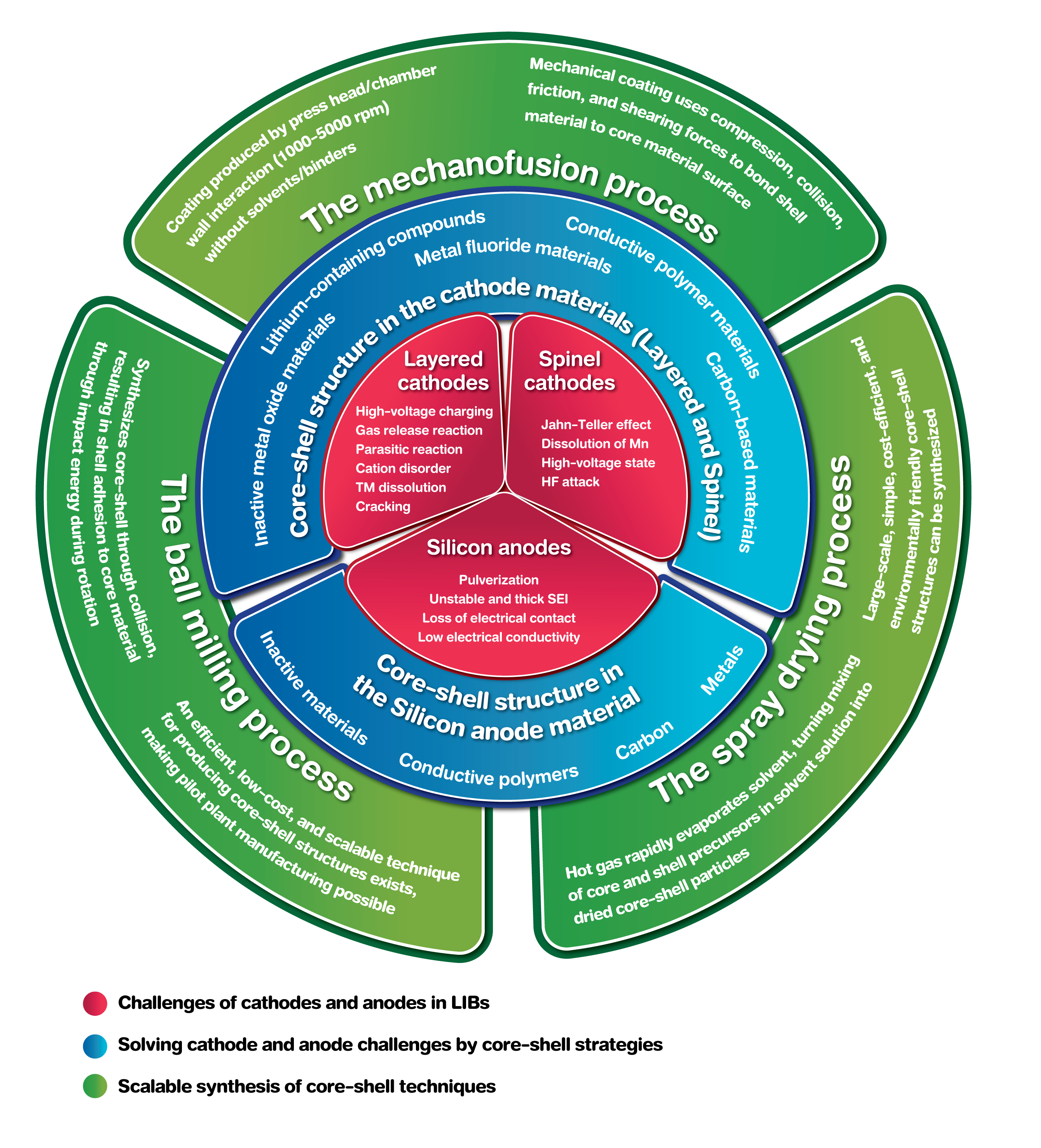

7. Improving the performance of an anionic MOF by counter cation replacement as electrode material in a full cell setup of a potassium ion capacitor
Chalita Aphirakaramwong, Oluseun Akintola, Christian T Plass, Montree Sawangphruk, Winfried Plass, Andrea Balducci
RSC Advances, 2023, 13, 12277-12284
DOI: https://pubs.rsc.org/en/content/articlehtml/2023/ra/d3ra01746j
Abstract: Potassium-based energy storage devices are attracting increasing attention as an alternative to lithium and sodium systems. In addition, metal–organic frameworks (MOFs) can be considered as promising electrode materials for this type of device due to their advantageous properties. Herein, the anionic MOF JUMP-1 and its analog with pre-loading of potassium cations, namely JUMP-1(K), were synthesized and characterized. The anionic framework of JUMP-1 is found to be extremely stable towards the exchange of the dimethylammonium cations by potassium ions. These MOFs were tested in composite electrodes in combination with conventional organic electrolytes as anode materials in a potassium-based system, including the full cell assembly of a potassium ion capacitor (KIC). The results show the significant improvement in capacity between the pristine JUMP-1 and the potassium-exchanged analog JUMP-1(K) as electrode materials. KICs containing JUMP-1(K) coupled with activated carbon (AC) display a promising stability over 4000 cycles. According to the results from these studies, the composite MOF electrode with the potassium-exchange analog JUMP-1(K) presents a promising approach, for which the electrochemical performance compared to the pristine anionic MOF is significantly enhanced.
8. An old blending strategy can enhance capacity retention of Ni-rich cathode materials
Puttida Nanthamitr, Chanikarn Tomon, Chonticha Jangsan, Thitiphum Sangsanit, Worapol Tejangkura, Nattanon Joraleechanchai, Montree Sawangphruk
Journal of Alloys and Compounds, 2023, 948, 169795
DOI: https://doi.org/10.1016/j.jallcom.2023.169795
Abstract: Ni-rich cathode materials, specifically NMC811, have high specific energy that make them suitable for various applications, including long-range electric vehicles (EVs). However, their intrinsic drawbacks, such as particle cracking, lattice oxygen release, surface reconstruction, and Li/Ni ion mixing, limit their practical uses due to safety concerns and low cycle life. Although numerous approaches have been used to deal with these downsides, none of them is yet considered the best, and they have increased the time and cost of production. This research aims to reduce the inherent shortcomings of NMC811 by using an old blending concept between NMC811 and LMO, which is commercially practicable and affordable. By carefully adjusting the blend to a weight ratio of 2:1, a blended NMC811/LMO cathode can provide superior capacity retention of over 50% after 750 cycles, which is better than the pristine NMC811. Additionally, the specific capacity increases by about 54% when compared to pristine LMO. This optimal blend of NMC811 and LMO presented here is believed to be one of the best ways to address the inherent disadvantages of Ni-rich cathode materials and could lead to useful applications such as long-range electric vehicles.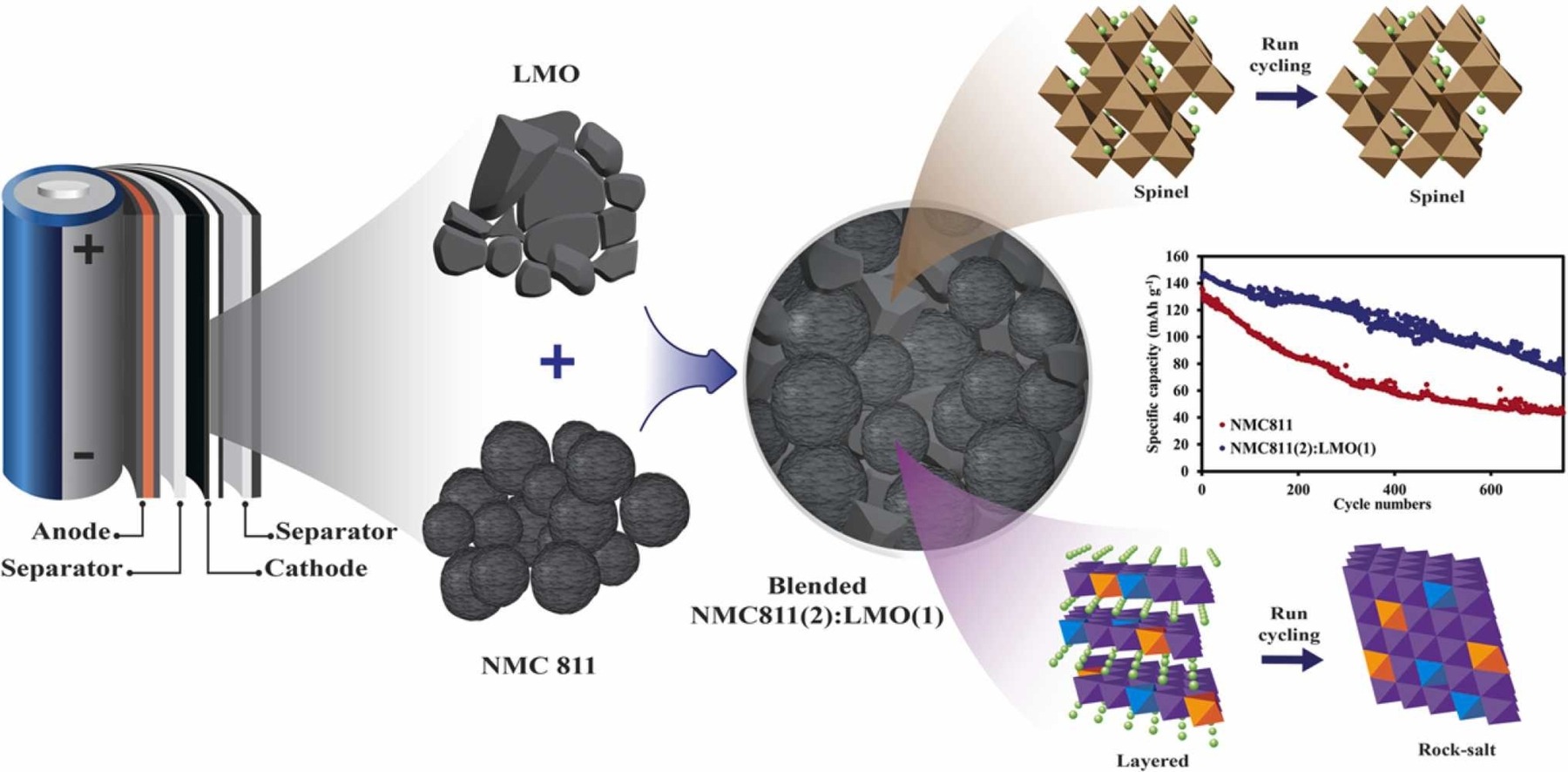

9. Low-cost, facile droplet modification of screen-printed arrays for internally validated electrochemical detection of serum procalcitonin
Paulo Roberto de Oliveira, Robert D Crapnell, Alejandro Garcia-Miranda Ferrari, Phatsawit Wuamprakhon, Nicholas J Hurst, Nina C Dempsey-Hibbert, Montree Sawangphruk, Bruno Campos Janegitz, Craig E Banks
Biosensors and Bioelectronics, 2023, 228, 115220
DOI: https://doi.org/10.1016/j.bios.2023.115220
Abstract: This manuscript presents the design and facile production of screen-printed arrays (SPAs) for the internally validated determination of raised levels of serum procalcitonin (PCT). The screen-printing methodology produced SPAs with six individual working electrodes that exhibit an inter-array reproducibility of 3.64% and 5.51% for the electrochemically active surface area and heterogenous electrochemical rate constant respectively. The SPAs were modified with antibodies specific for the detection of PCT through a facile methodology, where each stage simply uses droplets incubated on the surface, allowing for their mass-production. This platform was used for the detection of PCT, achieving a linear dynamic range between 1 and 10 ng mL−1 with a sensor sensitivity of 1.35 × 10−10 NIC%/ng mL−1. The SPA produced an intra- and inter-day %RSD of 4.00 and 5.05%, with a material cost of £1.14. Internally validated human serum results (3 sample measurements, 3 control) for raised levels of PCT (>2 ng mL−1) were obtained, with no interference effects seen from CRP and IL-6. This SPA platform has the potential to offer clinicians vital information to rapidly begin treatment for “query sepsis” patients while awaiting results from more lengthy remote laboratory testing methods. Analytical ranges tested make this an ideal approach for rapid testing in specific patient populations (such as neonates or critically ill patients) in which PCT ranges are inherently wider. Due to the facile modification methods, we predict this could be used for various analytes on a single array, or the array increased further to maintain the internal validation of the system.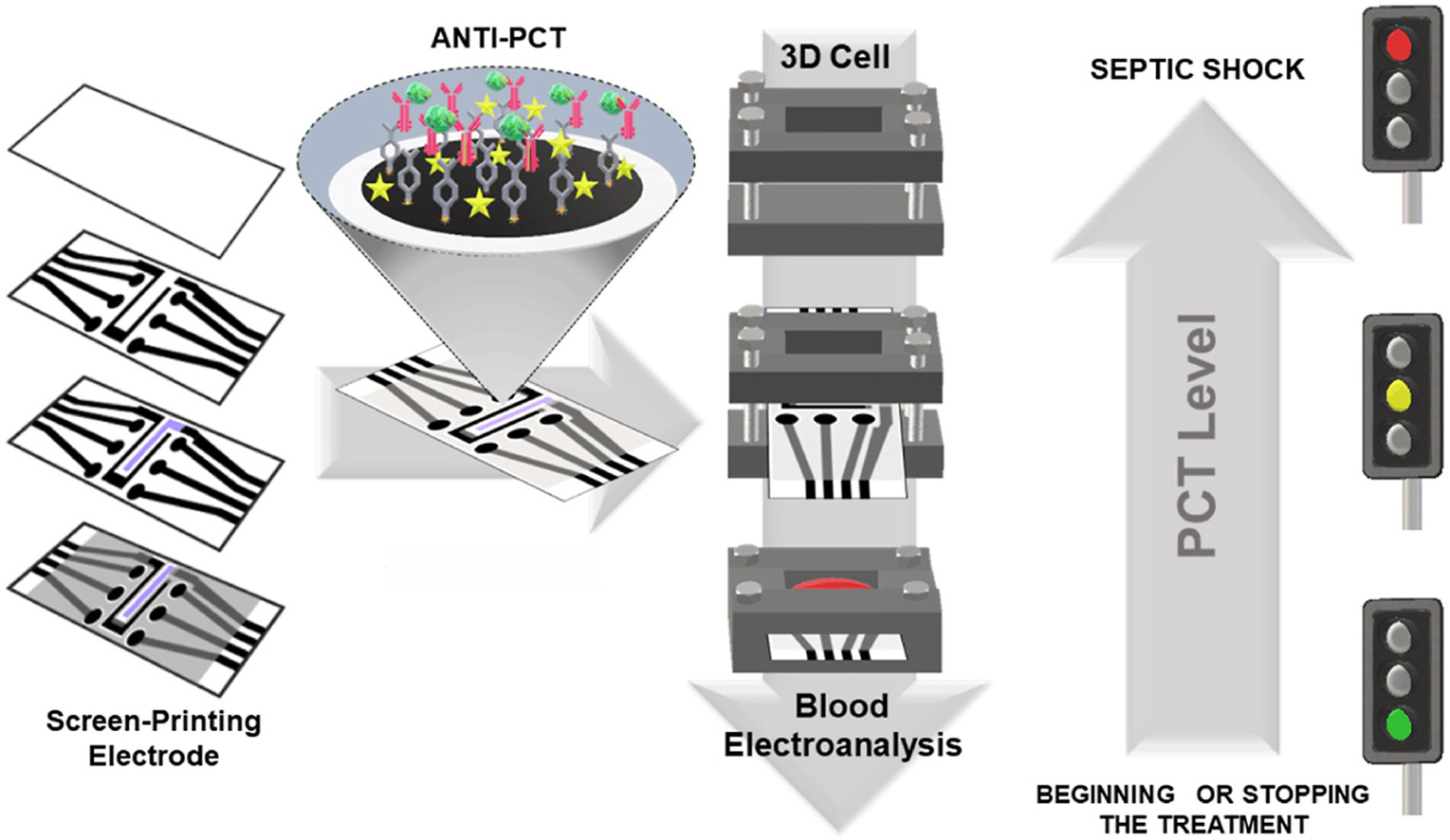

10. Exploring the Role of the Connection Length of Screen-Printed Electrodes towards the Hydrogen and Oxygen Evolution Reactions
Phatsawit Wuamprakhon, Alejandro Garcia-Miranda Ferrari, Robert D Crapnell, Jessica L Pimlott, Samuel J Rowley-Neale, Trevor J Davies, Montree Sawangphruk, Craig E Banks
Sensors, 2023, 23, 1360
DOI: https://www.mdpi.com/1424-8220/23/3/1360
Abstract: Zero-emission hydrogen and oxygen production are critical for the UK to reach net-zero greenhouse gasses by 2050. Electrochemical techniques such as water splitting (electrolysis) coupled with renewables energy can provide a unique approach to achieving zero emissions. Many studies exploring electrocatalysts need to “electrically wire” to their material to measure their performance, which usually involves immobilization upon a solid electrode. We demonstrate that significant differences in the calculated onset potential for both the hydrogen evolution reaction (HER) and oxygen evolution reaction (OER) can be observed when using screen-printed electrodes (SPEs) of differing connection lengths which are immobilized with a range of electrocatalysts. This can lead to false improvements in the reported performance of different electrocatalysts and poor comparisons between the literature. Through the use of electrochemical impedance spectroscopy, uncompensated ohmic resistance can be overcome providing more accurate Tafel analysis.
11. Sustainable Reuse and Recycling of Spent Li‐Ion batteries from Electric Vehicles: Chemical, Environmental, and Economical Perspectives
Kanit Hantanasirisakul, Montree Sawangphruk
Global Challenges, 2023
DOI: https://onlinelibrary.wiley.com/doi/full/10.1002/gch2.202200212
Abstract: The rapidly increasing adoption of electric vehicles (EVs) worldwide is causing high demand for production of lithium-ion batteries (LIBs). Tremendous efforts have been made to develop different components of LIBs in addition to design of battery pack architectures as well as manufacturing processes to make better batteries with affordable prices. Nonetheless, sustainable use of LIBs relies on the availability and cost of rare metals, which are naturally concentrated in a few countries. In addition, toxic electrolytes used in LIBs pose concerns on environmental impacts if LIBs are not handled properly after decommissioned from EVs. Therefore, it is paramount to realize effective utilization of spent LIBs, where their remaining capacities can be reused in less demanding applications. Finally, electrode materials and other valuable components of LIBs can be recovered via recycling, completing their circular life cycle. In this review, available options of LIBs after their retirement from EV applications, including battery second use, repair of electrode materials by direct regeneration, and material recovery by hydrometallurgical or pyrometallurgical processes are discussed. Throughout the review, the discussion is based around current available technologies, their environmental impacts, and economic feasibility as well as provided examples of pilot and industrial scale adoption of the processes.
12. Reducing Intrinsic Drawbacks of Ni-rich Layered Oxide with a Multifunctional Materials Dry-Coating Strategy
Nichakarn Anansuksawat, Poraman Chiochan, Kan Homlamai, Nattanon Joraleechanchai, Worapol Tejangkura, Montree Sawangphruk
Journal of Power Sources, 2023, 554, 232324
DOI: https://doi.org/10.1016/j.jpowsour.2022.232324
Abstract: Herein, we introduce a multifunctional materials dry coating strategy on LiNi0.8Mn0.1Co0.1O2 (NMC811) at 1 wt% with a thickness of ca. 100 nm. The materials included high chemical stable Al2O3 (0.33 wt%) to reduce parasitic reactions, high electrical carbon black (0.33 wt%) to reduce internal charge transfer resistance, and high ionic conductive Li7La3Zr2O12 (0.33 wt%) to enhance Li+ diffusion. The scalable dry coating mechanofusion used can also generate a smooth surface of spherical NMC811 particles enhancing its stability. With an exceptional property of mixed multi-functional materials, the cell of encapsulated NMC811 can perform up to 1000 cycles with 80% capacity retention. Whilst the pristine NMC811 cell can maintain only 39%. The coated NMC811 provides a two-fold specific capacity at a high C-rate (2.0C) compared to the pristine one. Moreover, it also offers excellent safety based on the UN38.3 standard at 18650 cylindrical cells. This multifunctional coating concept may lead to the further development of high-performance Li-ion batteries.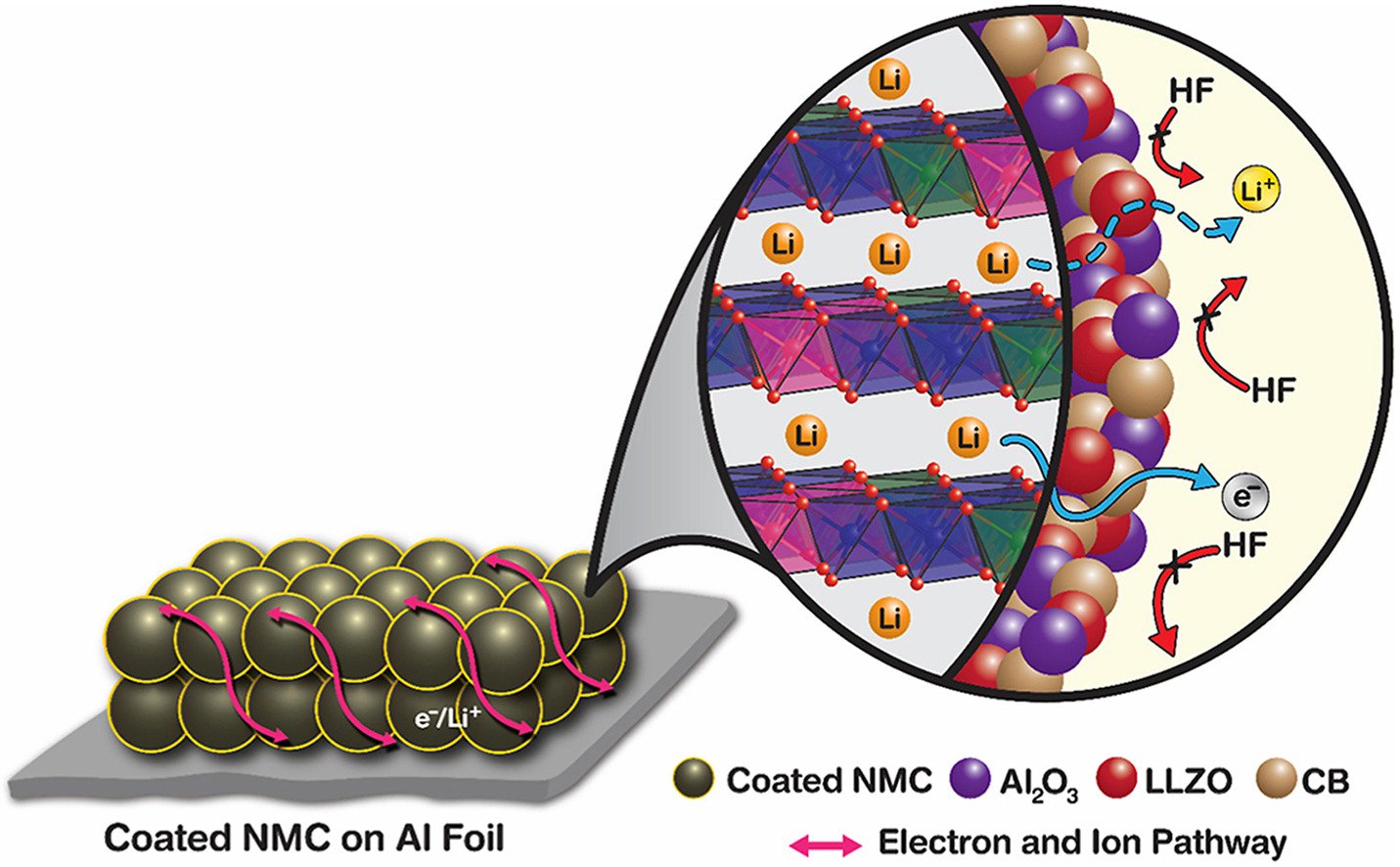

13. Utilizing the built-in electric field of pn heterojunction to spatially separate the photogenerated charges in C, N co-doped Co3O4/CdS photocatalysts
Tingzhen Chen, Chengwu Yang, Saravanan Rajendran, Montree Sawangphruk, Xinyu Zhang, Jiaqian Qin
Fuel, 2023, 331, 125594
DOI: https://doi.org/10.1016/j.fuel.2022.125594
Abstract: As one of the most effective strategies for the storage and utilization of solar energy, the development of photocatalytic technology has received extensive attention. The core work, the design and modification of photocatalysts, is very significance. Herein, we prepared C, N co-doped Co3O4 (CN-CoO) by a simple method and composited it with CdS to form CN-CoO/CdS p-n type heterojunctions. The prepared materials are characterized by numerous tests, such as XRD, SEM, TEM, XPS, and photoelectrochemical measurement. Due to the excellent electrochemical performance of CN-CoO and the built-in electric field in CN-CoO/CdS, the efficient separation of photogenerated charges is realized. Compared with CdS (1.11 ns), the average carrier lifetimes of the 15%CN-CoO/CdS (1.63 ns) is prolonged, which enhances photocatalytic hydrogen evolution activity of the composite materials. The hydrogen evolution rate of the optimal 15%CN-CoO/CdS is 6.78-fold greater than that of pristine CdS, and is as high as 64.36 mmol·g−1·h−1. Meanwhile, the 15%CN-CoO/CdS exhibits outstanding chemical stability after cyclic hydrogen production experiment for 30 h, and its apparent quantum efficiency (AQE) reaches 27.47% under monochromatic light at 405 nm. In addition, the formation process and photocatalytic hydrogen evolution mechanism of the CN-CoO/CdS p-n type heterojunctions are analyzed and discussed. This work provides a new idea for the construction of efficient photocatalytic heterojunctions through the modification and combination of semiconductors.
